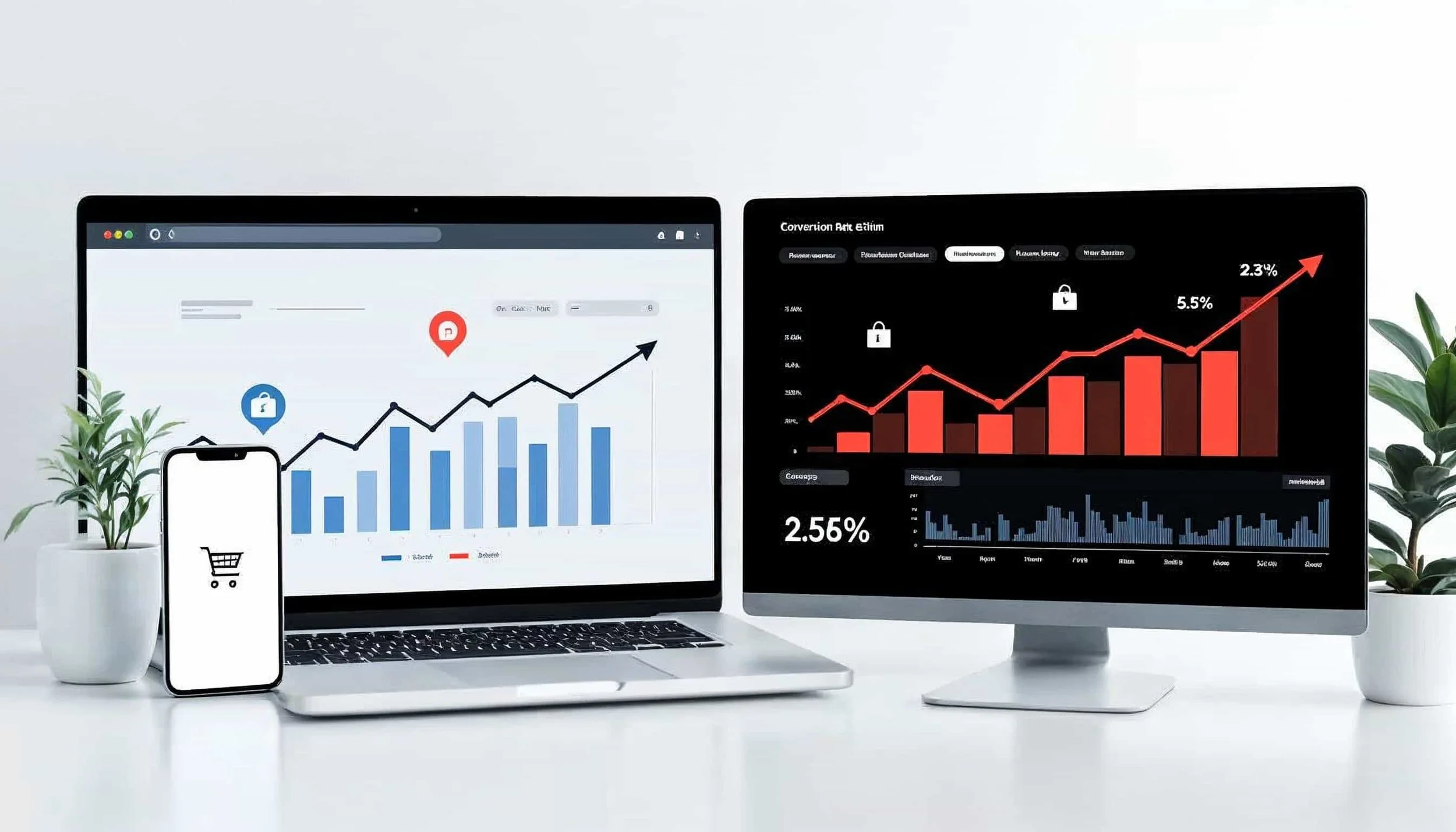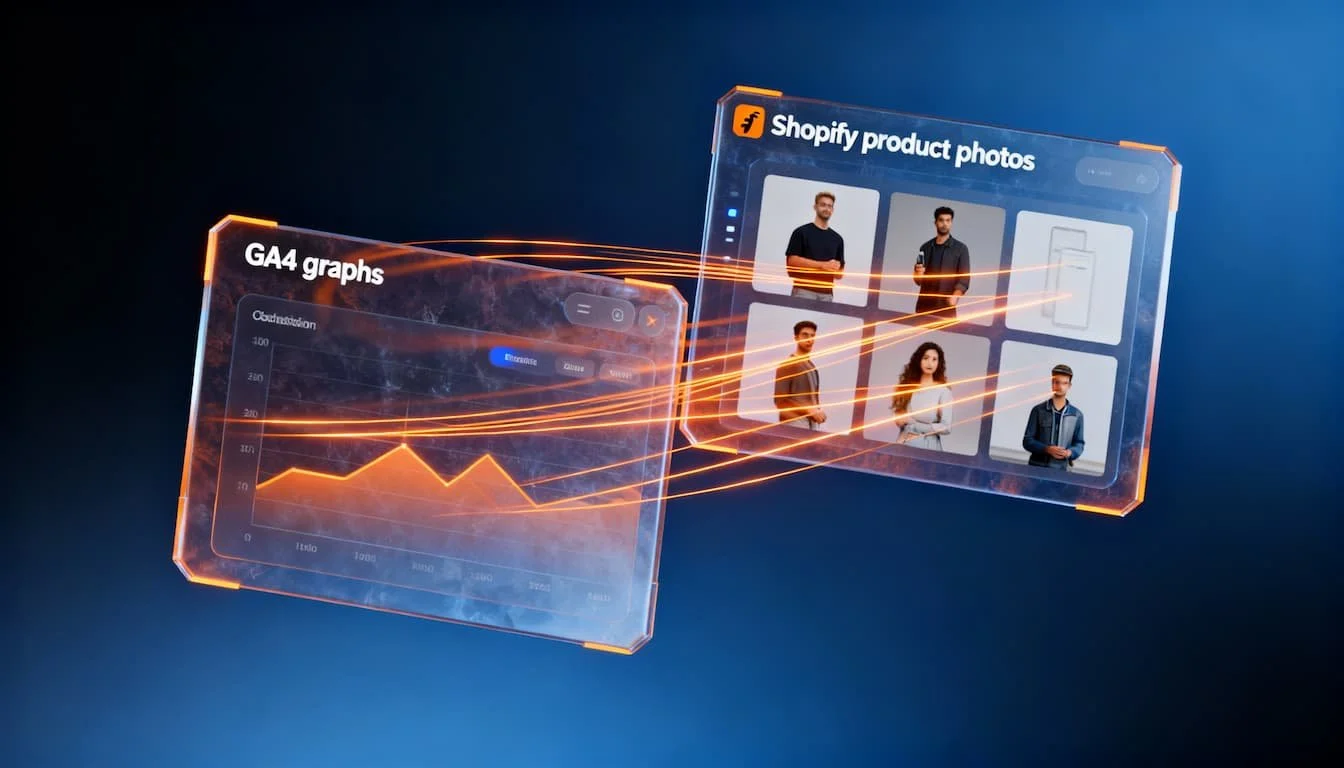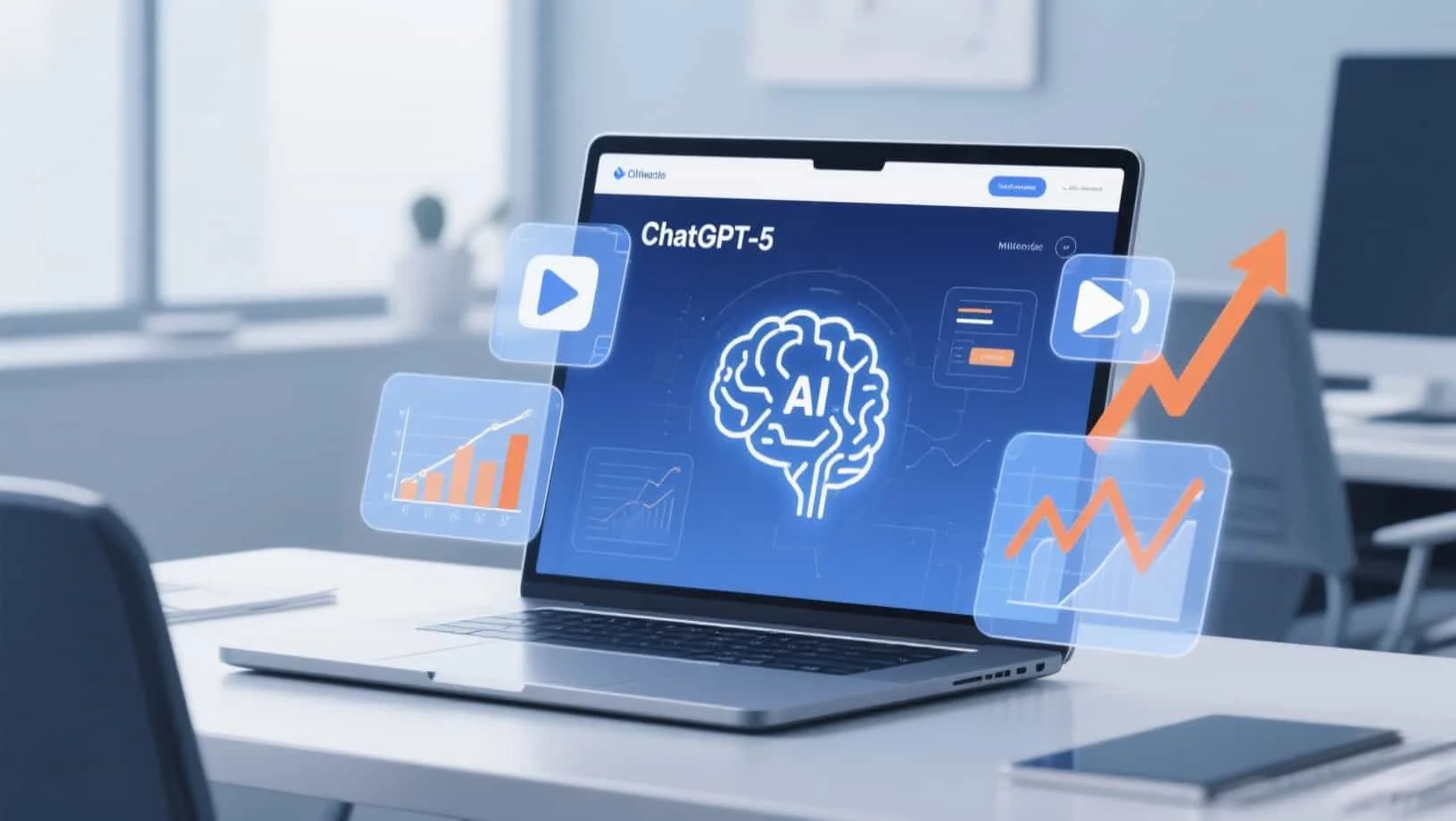E-commerce conversion optimization: 12 strategies for more sales
You've attracted visitors to your webshop via SEO, online advertising and social media. But where other entrepreneurs stop, your greatest opportunity lies: optimizing conversions. In 2025, smart conversion optimization strategies will determine the difference between mediocre results and explosive growth.
- Analysis-first: Google Analytics, Hotjar for bounce rate, page views, and conversion funnel
- UX fundamentals: Fast loading time, mobile-friendliness, clear navigation, and prominent CTAs
- Product pages: High-quality images, detailed descriptions, reviews, and transparent pricing
- Checkout optimization: Guest checkout, minimal fields, security badges, and progress bar
- Social proof: Customer reviews, testimonials, social media presence for trust
This guide shows you proven conversion techniques that deliver direct impact, from fundamental website optimizations to advanced behavioral triggers. Ready to get more revenue from your existing visitors?
Why conversion optimization is the ROI multiplier of 2025
Every euro spent on traffic only becomes valuable when visitors actually buy. The hard reality? The average e-commerce conversion rate is around 2.3% - which means that 97.7% of your visitors leave without making a purchase.
The numbers speak for themselves:
Companies that actively engage in conversion optimization see an average of 22% revenue growth (Adobe)
A 1% improvement in conversion delivers the same ROI as 10% more traffic (Eisenberg Holdings)
68% of companies with the highest growth invest structurally in conversion optimization (HubSpot)
“Companies are seeing real results with AI implementation: 68% are benefiting from task automation, 46% report improved customer experiences, and 44% are achieving better personalization.”
Source: Shapo.io - AI Marketing Tools That Actually Work
The beauty of conversion optimization? Your existing online marketing automatically becomes more effective. Paid ads get lower costs per purchase, SEO traffic delivers more, and social media posts generate more sales.
The conversion optimization fundamentals that will define 2025
1. Page speed as conversion killer number one
Website speed determines the first impression and purchase decision. In 2025, consumers expect pages to load within 2 seconds - on desktop and mobile.
Impact of loading times:
1 second delay = 7% fewer conversions (Akamai)
3+ seconds loading time = 53% of visitors leave the site on mobile (Google)
Amazon loses $1.6 billion per year with a 1-second slower loading time
Directly implementable optimizations:
WebP/AVIF images instead of JPEG for 30-50% smaller files
Critical CSS inline to display above-the-fold content immediately
Preload important resources such as main images and custom fonts
CDN implementation for global speed improvement
Database query optimization and server-side caching
Tools like PageSpeed Insights, GTmetrix, and Pingdom provide concrete action items. For Shopify webshops, apps like TinyIMG and SearchPie are effective for technical optimization.
2. Mobile-first conversion optimization
With 73% of e-commerce traffic via mobile devices, responsive design is no longer enough. Your webshop must be optimized mobile-first.
Mobile conversion optimizations:
Thumb-friendly navigation: Important buttons within thumb reach
Simplified forms: Use auto-complete and minimize typing
Touch-friendly buttons: Minimum 44px large with sufficient space
Swipe gestures for product galleries and navigation
Progressive Web App functionality for an app-like experience
Mobile checkout optimization:
Digital wallets such as Apple Pay and Google Pay for 1-click checkout
Prominent guest checkout - avoid mandatory registration
Address auto-completion via Google Places API
Sticky action buttons that always remain visible
“AI-powered email marketing tools can lead to significant improvements, such as 18% higher engagement and 76% lower bounce rates.”
Source: Shapo.io - AI Marketing Tools Performance Data
3. Trust signals that drive purchasing decisions
Trust is the foundation of online sales. In 2025, subtle trust signals will be more effective than flashy badges.
Proven trust elements:
Customer reviews on product pages with photos and verification
Real-time social proof: "23 people are viewing this product now"
Security badges on checkout and payment pages
Transparent shipping and return conditions
Live chat support during office hours
About us page with team photos and company story
Advanced trust strategies:
User-generated content via Instagram feeds and customer photos
Industry awards and certifications prominently displayed
Press mentions en media coverage
Satisfaction guarantees with simple claim processes
More tips on building online trust can be found in our guide on why hiring a marketing expert is smarter than doing it yourself.
4. Product page optimization for conversion
Your product pages are the digital salespeople of your online store. Every second and every pixel must contribute to the purchase decision.
Essential product page elements:
High-quality images: Minimum of 5 photos per product plus zoom function
360-degree product views for more complex products
Product videos show 80% higher conversions than photos alone
Clear unique selling points in bullet points above the fold
Stock indicators: "Only 3 left in stock" creates urgency
Copy optimization:
Benefit-oriented headlines instead of feature lists
Emotional triggers alongside rational arguments
Size guides and product comparisons reduce returns
Frequently Asked Questions section answers questions inline
“Data-driven content approaches can lead to more effective strategies, with some users reporting up to 15% growth in organic traffic within the first month of implementation.”
Source: Shapo.io - AI Content Marketing Tools Analysis
For extensive tips on product page optimization, check out our Shopify SEO checklist.
5. Checkout flow optimization
An optimized checkout can double your conversion rate. The rule is simple: the fewer steps, the higher the conversion.
Checkout best practices 2025:
One-page checkout if possible, otherwise max. 3 steps
Progress indicators show how many steps remain
Automatic saving functionality prevents data loss
Multiple payment options including buy-now-pay-later
Guest checkout prominent with option to create account afterwards
Countering shopping cart abandonment:
Exit-intent popups with last chance discounts
Abandoned cart emails within 1-2 hours of abandonment
SMS retargeting for high-value shopping carts
Retargeting ads with dynamic product feeds
Payment optimization:
Express checkout buttons such as Shop Pay and PayPal Express
Security guarantee at every payment step
Currency localization for international visitors
Tax and shipping calculator before checkout starts
Also read our complete guide on e-commerce trends in Belgium and why companies choose Shopify.
Advanced conversion optimization tactics for 2025
6. Behavioral triggers and urgency marketing
Psychological triggers influence buying behavior more than rational arguments. Use these ethically and effectively.
Scarcity marketing:
Limited stock indicators: "Only 3 available"
Time-sensitive offers: "Discount expires in 15 minutes"
Seasonal urgency: "Last chance for Christmas delivery"
Waitlist functionality for sold-out products
Social proof reinforcement:
Recent purchase notifications: "Jan from Amsterdam just bought this"
Popular product badges: "Bestseller this week"
Review notifications: "Maria gave this 5 stars"
Trending indicators: "1,243 people viewed this today"
For more about psychology in marketing, read our article about performance marketing in the AI era.
7. Cross-sell and upsell optimization
Increase your average order value by cleverly promoting relevant products.
Product bundling strategies:
Frequently bought together based on data, not guesswork
Complete the look for fashion and interior design
Layered product options (good, better, best)
Add-on products at checkout
Upsell timing optimization:
Pre-purchase upsells on product pages
Shopping cart page cross-sells before checkout starts
Post-purchase offers via order confirmation emails
Email upsells 3-7 days after delivery
For more strategies on increasing customer value, check out our AI for content creation service.
8. Personalization without AI complexity
You don't need an enterprise AI platform for effective personalization. Simple segmentation delivers immediate results.
Basic personalization tactics:
Geographic targeting: Local products and shipping options
Traffic source segmentation: Different landing pages per channel
Returning visitor recognition: Welcome messages and recently viewed items
Purchase history targeting: Show related products
Behavioral segmentation:
First-time visitors: Focus on brand trust and unique selling points
Returning visitors: Direct to popular categories
High-value customers: Exclusive products and early access
Shopping cart abandoners: Retargeting with incentives
For more advanced personalization with AI, read our article on AI-driven marketing strategies and consider an AI audit.
E-commerce specific conversion killers
9. Shipping and returns transparency
Unexpected costs are the biggest conversion killer. Be transparent from the start.
Shipping optimization:
Clearly communicate free shipping thresholds
Delivery date calculator on product pages
Express shipping options for urgent orders
International shipping clarity for export
Returns policy optimization:
30-day return guarantee as a minimum standard
Free return shipping significantly increases conversion
Return process explanation with photos and steps
Exchange options in addition to refunds
10. Search and navigation experience
If visitors don't find what they're looking for, they won't convert. Period.
Site search optimization:
Autocomplete functionality with popular search terms
Typo tolerance and synonym recognition
Search filters for price, brand, rating, and features
Visual search for fashion and interior products
Navigation best practices:
Mega menus with visual categories
Breadcrumb navigation on all pages
Filter persistence between pages
Related categories for empty search results
11. Customer service as conversion driver
Proactive customer service increases conversions and reduces returns.
Live support optimization:
Chatbots for FAQs during off-hours
Live chat on product pages for more complex questions
Video calls for high-ticket items
WhatsApp Business integration for the Dutch market
Self-service options:
Extensive FAQ section with search functionality
Video tutorials for product usage
Size guides with photo examples
Comparison tools between products
12. Data-driven optimization culture
CRO is not a one-off action but a continuous process of testing and improvement.
Test tool alternatives for Google Optimize:
VWO (Visual Website Optimizer): Extensive A/B testing with Dutch support
Optimizely: Enterprise-level testing platform with machine learning
Microsoft Clarity: Free heatmaps and session recordings
Hotjar: User behavior insights and feedback tools
AB Tasty: All-in-one personalization and testing platform
Tracking key metrics:
Conversion rate per traffic source and device
Average order value trends and optimizations
Shopping cart abandonment rate and recovery rate
Page load speed impact on conversions
Customer lifetime value for long-term ROI
Discover more about data-driven marketing in our guide on digital marketing analysis.
“Platforms like Sprout Social can reduce manual data aggregation time by as much as 75%, leading to improved efficiency in marketing operations.”
Source: Sprout Social - AI Marketing Tools for Smart Work
Directly implementable conversion optimization checklist
Week 1-2: Technical foundation
Page speed audit en optimalisatie naar <3 seconden
Mobile responsiveness check on real devices
Implement SSL certificate and security badges
Install Google Analytics 4 and heatmap tools
Week 3-4: User experience basics
Reduce checkout flow to a maximum of 3 steps
Make guest checkout option prominent
Optimize product page photos (minimum 5 per product)
Add trust signals to every product page
Week 5-6: Conversion elements
Implement exit-intent popups
Activate abandoned cart email sequence
Add cross-sell widgets on cart page
Activate review system with automated requests
Week 7-8: Advanced optimization
A/B test different CTA button colors and texts
Implement personalization based on traffic source
Test urgency elements (stock indicators, timer)
Implement mobile-specific optimizations
Return on conversion optimization investments
Short term impact (1-3 months):
Technical optimizations: 10-25% conversion improvement
UX improvements: 15-30% higher conversion rate
Trust signals: 8-20% more sales
Mobile optimization: 20-40% better mobile conversion
Long-term benefits (6-12 months):
Customer lifetime value increase due to better first experience
Lower customer acquisition costs due to higher conversions
Improved organic rankings due to better user signals
Higher profit margins without extra marketing expenses
Case study results from clients:
Beauty retailer: 156% conversion increase in 4 months
Fashion webshop: 89% higher mobile conversions
Electronics store: 234% improvement in average order value
B2B marketplace: 67% more qualified leads
The investment in professional CRO typically pays for itself within 2-4 months through higher revenue from existing traffic.
Ready to take your e-commerce conversions to the next level? ClickForest helps Dutch and Belgian webshops double their revenue through proven conversion optimization strategies and Shopify optimization. Schedule a free strategy session or start with a webshop audit to discover your conversion potential.

🚀 More leads, higher conversion, better ROI
This article gave you insights. Now it's time for action. Whether you want to build a profitable webshop, generate more revenue from performance marketing or SEO, or grow with AI-marketing - we'll help you move forward concretely.
💬 Discuss your challenge directly with Frederiek: Schedule a free strategy session or send us a message
📧 Prefer to email? Send your question to frederiek@clickforest.com or call +32 473 84 66 27
Strategy without action remains theory. Let's take your next step together.
Frequently asked questions about e-commerce CRO
-
On average, the e-commerce conversion rate is around 2-3%, but this varies greatly per sector. Fashion 1-2%, electronics 2-3%, luxury goods 0.5-2%, beauty 3-4%. Focus on improvement compared to your own baseline.
-
Technical improvements (page speed, mobile) show direct impact. UX optimizations need 2-4 weeks for reliable data. Continuous optimization shows the best results after 3-6 months.
-
Google Analytics 4 for data, Hotjar or Microsoft Clarity for heatmaps, VWO or AB Tasty for A/B testing (now that Google Optimize has stopped), Mailchimp or Klaviyo for email automation. Start with free tools before you invest in premium software.
-
Test one element at a time, use non-overlapping target groups, and do not test on the same pages simultaneously. With limited traffic, focus on sequential tests instead of parallel tests.
-
Mandatory account registration, unclear shipping costs, no iDEAL/Bancontact payments, English-only content, and not testing Black Friday/Sinterklaas-specific optimizations.
-
Calculate the increase in conversion value, deduct implementation costs, and include the compound effect over 12 months. Don't forget to include customer lifetime value for a complete ROI calculation.
-
Absolutely. Focus on lead qualification, quotation request optimization, bulk pricing transparency, and technical specification clarity. B2B has longer decision cycles but higher order values.
-
Continuous optimization works best. Plan at least 1 test per month, analyze after 2-4 weeks, and implement winners permanently. Test major redesigns in advance with user testing.
-
Yes, they reinforce each other. Good user experience improves search rankings, while better content helps both SEO and conversions. Ensure that tests do not negatively impact page loading speed.
-
Conversion optimization focuses specifically on conversion optimization within existing traffic. Growth hacking is broader and includes traffic acquisition, viral mechanisms, and retention strategies. CRO is a part of growth hacking.
-
Mandatory account registration, unclear shipping costs, no iDEAL/Bancontact payments, English-only content, and not testing Black Friday/Sinterklaas-specific optimizations.
-
Calculate the increase in conversion value, deduct implementation costs, and include the compound effect over 12 months. Don't forget to include customer lifetime value for a complete ROI calculation.
-
Absolutely. Focus on lead qualification, request-quote optimization, bulk pricing transparency, and technical specification clarity. B2B has longer decision cycles but higher order values.
-
Continuous optimization works best. Plan at least 1 test per month, analyze after 2-4 weeks, and implement winners permanently. Test major redesigns in advance with user testing.
-
Yes, they reinforce each other. Good user experience improves search rankings, while better content helps both SEO and conversions. Ensure that CRO tests do not negatively impact page load speed.
-
CRO focuses specifically on conversion optimization within existing traffic. Growth hacking is broader and includes traffic acquisition, viral mechanics, and retention strategies. CRO is a part of growth hacking.
Sources and references
Conversion optimization research and benchmarks:
Adobe: "Digital Economy Index 2024: E-commerce Conversion Benchmarks" - https://business.adobe.com/resources/digital-economy-index.html
Baymard Institute: "Shopping Cart Abandonment Statistics and Email Retargeting" - https://baymard.com/lists/cart-abandonment-rate
Eisenberg Holdings: "Buyer Legends: The Definitive Storyteller's Guide" - https://www.eisenbergholdings.com/buyer-legends/
HubSpot: "The State of Marketing Report 2024" - https://www.hubspot.com/state-of-marketing
E-commerce optimization strategies:
Shopify Plus: "Conversion Rate Optimization Guide for Enterprise Merchants" - https://www.shopify.com/plus/guides/conversion-rate-optimization
Google: "Mobile Page Speed New Industry Benchmarks" - https://developers.google.com/web/updates/2018/07/search-ads-speed
Akamai: "Performance Matters: How Milliseconds Impact Your Bottom Line" - https://www.akamai.com/newsroom/press-release/akamai-releases-spring-2017-state-of-online-retail-performance-report
Klaviyo: "E-commerce Email Marketing Benchmarks 2024" - https://www.klaviyo.com/marketing-resources/articles/email-marketing-benchmarks
User experience and behavioral psychology:
Nielsen Norman Group: "E-commerce User Experience Research Findings" - https://www.nngroup.com/articles/ecommerce-checkout/
ConversionXL: "Psychology of Persuasion in E-commerce Optimization" - https://conversionxl.com/blog/psychology-of-persuasion/
Unbounce: "Landing Page Conversion Benchmark Report" - https://unbounce.com/conversion-benchmark-report/











